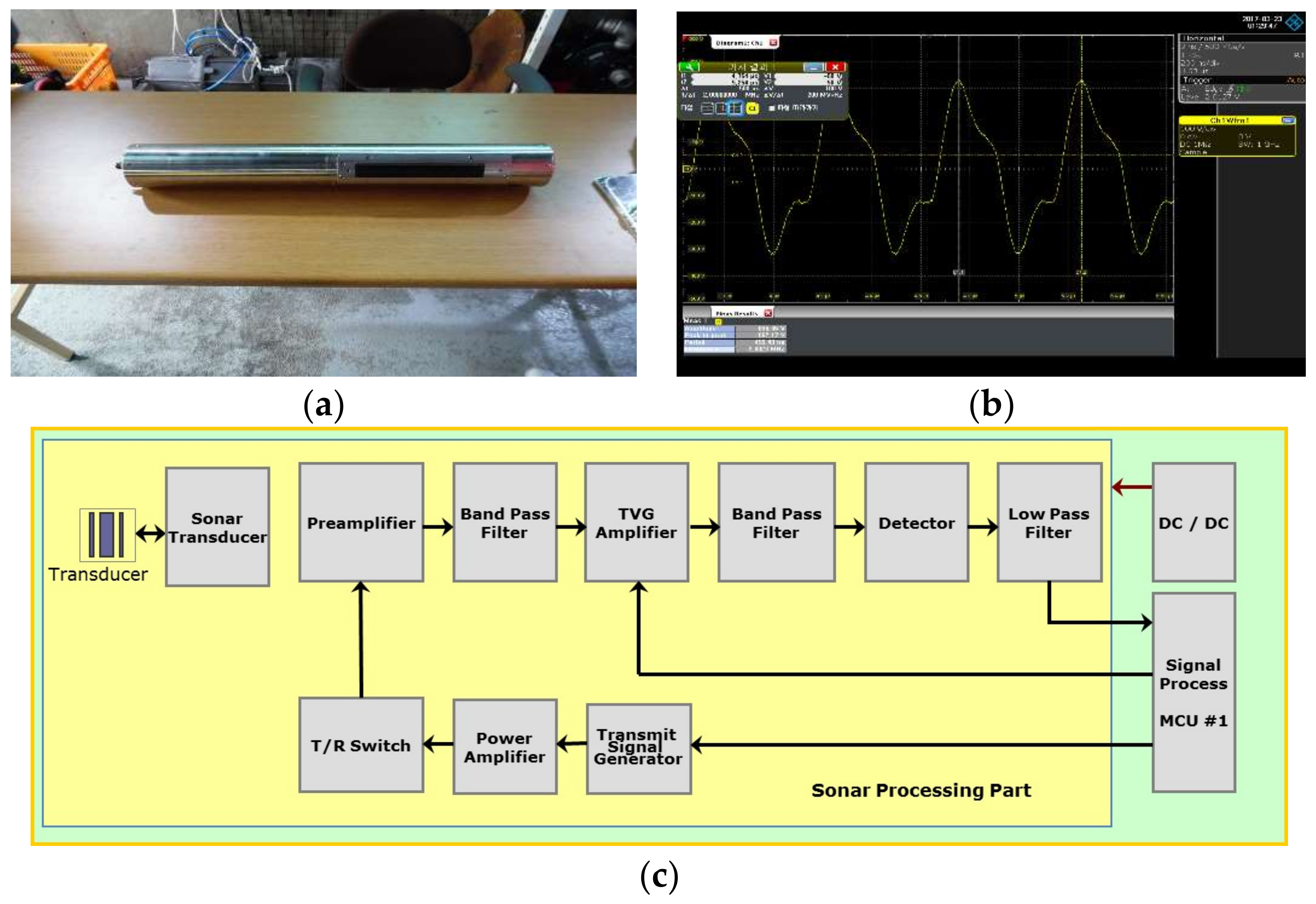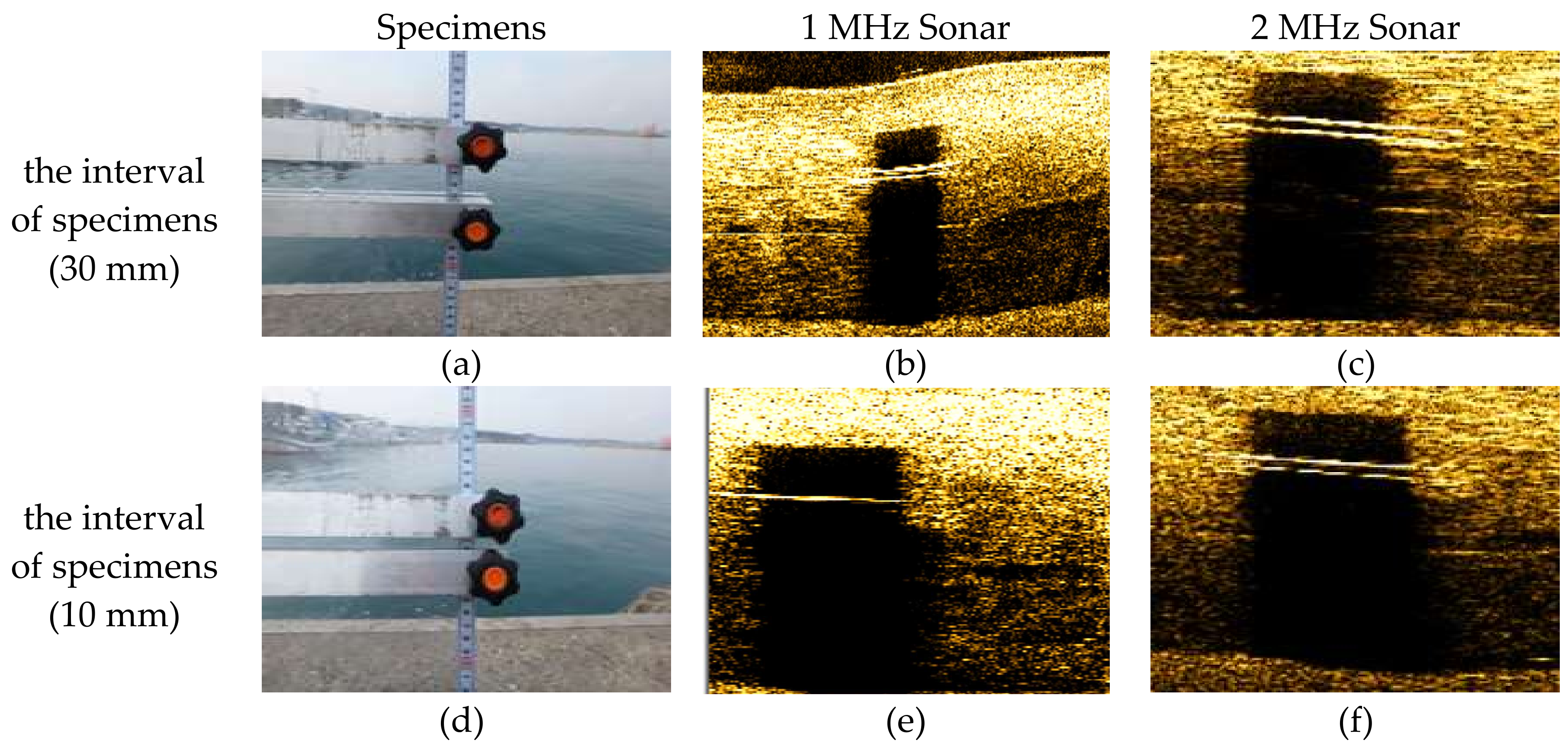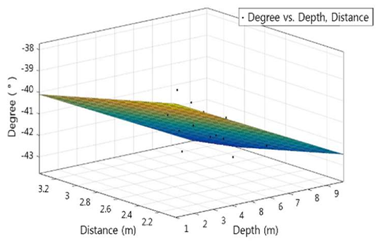Development of a 2 MHz Sonar Sensor for Inspection of Bridge Substructures
Abstract
:1. Introduction
2. Trend of Technology and Analysis of Problem
2.1. Trend of Technology
2.2. Analysis of Problem
3. Development of the 2 MHz Side Scan Sonar Sensor Module
3.1. Principles of Side Scan Sonar
3.2. Development of the 2 MHz Sonar Sensor Module
3.3. Development of the Electric Jig
4. Applicability of the 2 MHz Side Scan Sonar
4.1. Resolution of the 2 MHz Side Scan Sonar
4.2. The 2 MHz Sonar Operation Technique through Regression Analysis
5. Conclusions
- In order to have a resolution of 10 mm, the frequency of the sonar sensor was selected to be in the 2 MHz band and the transmission angle of the sonar sensor is 0.29°. The length of the sensor is 185.59 mm, and the width of the piezoelectric ceramic is designed to form a beam of about 50° to obtain an image of the SSS. It was confirmed that the developed 2 MHz side scan sonar sensor module is 499.43 ns which satisfies the period criteria value 500 ns ± 10% and 2.0023 MHz which satisfies the output frequency criteria value 2 MHz ± 10%.
- To survey the faces of underwater structures effectively and quickly, an electric jig integrated with the 2 MHz side scan sonar was developed. The angle control motor has a resolution of 1°/s, the resisting tolerance of the applied motor is ±5%, the effective angle is 353 ± 1.5° and the coupling accuracy is ±1°.
- To confirm the resolution of the developed 2 MHz side scan sonar, the resolution was checked by adjusting the spacing between the specimens. The resolution of the 1 MHz side scan sonar was found to be maximum 30 mm and it was confirmed that the developed 2 MHz side scan sonar showed resolution of 10 mm.
- When operating the sonar, the resolution of the sonar data is changed according to the influencing factors such as the angle of survey, the distance to the structure, and the depth of water. We used 20 sample data to analyze the correlation and derive a multiple regression model. The effect of the distance between the water depth and the structure on the survey angle was confirmed to be 66~82%. The significance test was confirmed by t-test, and the distance between the water depth and the structure was found to have a major influence on the survey angle. Based on the equation derived from the above regression analysis model, the correlation among the depth of the water and the distance to the structure and the operating method of towfish angle were derived.
Acknowledgments
Author Contributions
Conflicts of Interest
References
- Lee, G.C.; Mohan, S.B.; Huang, C.; Fard, B.N. A Study of U.S. Bridge Failures (1980–2012), Multidisciplinary Center for Earthquake Engineering Research; Technical Report MCEER-13-0008; Earthquake Engineering to Extreme Events: Buffalo, NY, USA, 2013. [Google Scholar]
- Kim, Y.; Lee, H.; Park, C.; Choi, S. A Study for Optimum Survey Method of Underwater Structure Using the Dual Sonar Sensor. J. Sens. 2017, 2017, 9206898. [Google Scholar] [CrossRef]
- Seo, J. Current Status and Prospects of Underwater Robot Industry. Korea Inst. Robot Ind. Adv. 2014, 2. Available online: https://www.kiria.org/planweb/board (accessed on 13 April 2018).
- Kye, J.E.; Cho, J.I.; Yoo, W.P.; Choi, S.L.; Park, J.H. Trends and Applications on Multi-beam Side Scan Sonar Sensor Technology. In Electronics and Telecommunications Trends; Electronics and Telecommunications Research Institute: Daejeon, Korea, 2013; pp. 167–169. [Google Scholar]
- Ainsilie, M.A. Principles of Sonar Performance Modeling; Geophysical Sciences; Springer: Berlin/Heidelberg, Germany, 2010; ISBN 978-3-540-87661-8. [Google Scholar]
- Klaucke, I. Sidescan Sonar. In Submarine Geomorphology; Springer International Publishing: Cham, Switzerland, 2018. [Google Scholar] [CrossRef]
- Kim, Y.; Park, C.; Choi, S. A Study of Operation Methods for Application of Safety Inspection of Underwater Structures using High Resolution Side Scan Sonar. J. Coast. Disaster Prev. 2016, 3, 67–73. [Google Scholar] [CrossRef]
- Ang, A.H.-S.; Tang, W.H. Probability Concepts in Engineering-Emphasis on Applications in Civil & Environmental Engineering; John Wiley & Sons, Inc.: Hoboken, NJ, USA, 2007; ISBN 978-89-8225-801-5. [Google Scholar]
- Lee, S.; Kim, D.; Choi, Y. Development of predictive model for the number of potholes using multi regression analysis. J. Korean Soc. Hazard Mitig. 2014, 14, 91–98. [Google Scholar] [CrossRef]
- Cha, K.; Kim, S.; Kim, J.; Park, M.; Kong, J. Development of the deterioration models for the port structures by the multiple regression analysis and markov chain. J. Comput. Struct. Eng. Inst. Korea 2015, 28, 229–239. [Google Scholar] [CrossRef]
- Chelgani, S.C.; Hart, B.; Grady, W.C.; Hower, J.C. Study relationship between inorganic and organic coal analysis with gross calorific value by multiple regression and ANFIS. Int. J. Coal Prep. Util. 2011, 31, 9–19. [Google Scholar] [CrossRef]
- Mokhtari, V. Regression analysis of factors in the agricultural production cooperative success of Ilam. J. Trends Adv. Sci. Eng. 2012, 4, 100–109. [Google Scholar]






| Hz | Wavelength | Effective Range |
|---|---|---|
| 100 Hz | 15 m | 1000 km |
| 1 kHz | 1.5 m | 100 km |
| 10 kHz | 15 cm | 10 km |
| 50 kHz | 3 cm | 1 km |
| 100 kHz | 1.5 cm | 600 m |
| 500 kHz | 3 mm | 150 m |
| 1 mHz | 1.5 mm | 50 m |
| No. | Substructure of Bridge | River(Sea) Bed | |||
|---|---|---|---|---|---|
| Water Depth (m) | Survey Angle (°) | Distance to Structure (m) | Survey Angle (°) | Distance to Structure (m) | |
| 1 | 4.3 | −40.1 | 2.5 | −2.7 | 6.5 |
| 2 | 3.8 | −39.5 | 2.4 | −2.9 | 4.3 |
| : | : | : | : | : | : |
| 20 | 4.4 | −42.2 | 2.6 | −2.1 | 5.1 |
| Class. | Substructure of Bridge | River(Sea) Bed |
|---|---|---|
| Graph |  |  |
| SSE | 6.012 | 2.787 |
| R-square | 0.8466 | 0.7019 |
| Adjusted R-square | 0.8262 | 0.6622 |
| RMSE | 0.6331 | 0.4311 |
| Class | Effective Factors | B | β | t | p |
|---|---|---|---|---|---|
| Substructure of bridge | Water depth | −0.452 | 0.700 | −3.827 | 0.002 |
| Distance to structure | −1.227 | −0.252 | −1.378 | 0.189 | |
| River(sea) bed | Water depth | −0.160 | −0.507 | −1.146 | 0.270 |
| Distance to structure | −0.124 | −0.341 | −0.772 | 0.452 |
© 2018 by the authors. Licensee MDPI, Basel, Switzerland. This article is an open access article distributed under the terms and conditions of the Creative Commons Attribution (CC BY) license (http://creativecommons.org/licenses/by/4.0/).
Share and Cite
Park, C.; Kim, Y.; Lee, H.; Choi, S.; Jung, H. Development of a 2 MHz Sonar Sensor for Inspection of Bridge Substructures. Sensors 2018, 18, 1222. https://doi.org/10.3390/s18041222
Park C, Kim Y, Lee H, Choi S, Jung H. Development of a 2 MHz Sonar Sensor for Inspection of Bridge Substructures. Sensors. 2018; 18(4):1222. https://doi.org/10.3390/s18041222
Chicago/Turabian StylePark, Chul, Youngseok Kim, Heungsu Lee, Sangsik Choi, and Haewook Jung. 2018. "Development of a 2 MHz Sonar Sensor for Inspection of Bridge Substructures" Sensors 18, no. 4: 1222. https://doi.org/10.3390/s18041222





